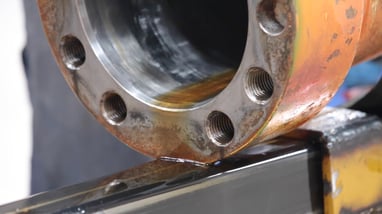
Hydraulic fluid is the lifeblood of your hydraulic system. This incompressible liquid does more than transmit force, it is also responsible for lubricating many moving mechanical parts. The friction-reducing properties of hydraulic fluid prevent components such as bearings, pistons, pump vanes from grinding, eroding and tearing themselves apart. However, hydraulic fluid is a wear item itself and will degrade as it ages due to exposure to several operating factors such as excessive temperatures or various contaminants. When it degrades, it loses the ability to defend against friction and corrosion.
That’s why maintaining your fluid in good condition is vital to the performance and longevity of your equipment. In this article, we’ll discuss the most common causes of hydraulic fluid degradation so that you can avoid nasty surprises.
The top 5 reasons for hydraulic fluid degradation
Water Contamination
It takes very little water in a hydraulic system to severely affect its longevity. In fact, less than 1% water contamination has been found to reduce hydraulic pump bearing life by 50% and compromise performance too. Not only does the presence of water increase corrosion within the system, it changes the property of the hydraulic fluid, which means many of the key functions of the fluid are compromised. Oil and water don’t mix, so when pressure and motion is introduced, water can have the effect of increasing foaming and cavitation within the hydraulic system, which dramatically increases friction and quickly erodes components such as seals, pistons and other parts. Water can make its way into the system through condensation and poor condition of seals and even improper fluid handling at the time of fluid changes. Take care to monitor the water contamination levels in your machines by analysing hydraulic fluid regularly and follow strict maintenance procedures when changing the oil to ensure you remove any water when draining.
Particulate Contamination
Particulate contamination refers to dirt, debris, metal shavings and any other small particles that build up in your hydraulic system over time and compromise its performance. Particulates may consist of metal slivers produced by cavitation issues or bits of dirt introduced into the system during maintenance, eventually, these particles make their way between seals, grind away at bearings, cause sticking valves, score pistons and other wear items. Particulates are perhaps the most destructive type of hydraulic fluid contamination and one of the major causes of hydraulic system failure. According to some studies, more than 80% of hydraulic component wear is directly related to increased levels of particulate matter in the hydraulic fluid. Particulate matter naturally increases through use and hydraulic systems employ fluid filters to combat this phenomenon.
Overheating
Overheating of hydraulic fluid compromises its ability to prevent friction in the system and dramatically increases wear and reduces the lifespan of components. High temperatures cause varnish to form in oil, which lowers the lubricating properties and increases viscosity. High heat also causes the fluid to break down by increasing oxidation, which produces acids that corrode metal parts. Exceeding recommended operating temperatures also causes oil additives to deteriorate, which may also increase friction and wear and reduce corrosion resistance. Some common causes of overheating oil are flow restriction and excessive flow. Flow restriction is generally brought about through undersized system piping and use of devices such as flow controls and servo valves. Excessive flow velocities are caused by incorrectly sized fluid conductors, which can accelerate the flow of fluid. Hydraulic equipment that is prone to overheat issues, will need a higher frequency of fluid replacement.
Aeration
Aeration occurs when air leaks into a system - usually through seals and fittings - but can also be introduced during fluid replacement and maintenance. When air is introduced into the hydraulic fluid it occurs in four states with different properties and effects. These are: dissolved, entrained (air bubbles), free and foam. While these each have different effects, ultimately aeration accelerates the degradation of the fluid and causes damage to system components through the loss of lubrication, overheating and burning of seals. It can also lead to cavitation, spongy or slow hydraulic response and loss of control of the hydraulic system.
Cavitation
Unlike aeration, cavitation is not caused by air introduced from outside the system - it refers to the formation of vapor cavities within the hydraulic fluid. Cavitation occurs when the volume of fluid is insufficient for the demands of the hydraulic circuit, causing the pressure to fall below the vapor pressure of the hydraulic fluid, which results in the formation of bubbles of vaporised fluid. These bubbles rapidly implode generating intense mini shockwaves, which reduce power and are extremely detrimental to the internals of a hydraulic system. Over time, this condition erodes metallic surfaces through repeated mini implosions, causing metal fatigue and eventually small pieces of metal break off and those particulates then go on to wreak havoc on the system.
Protect your system from hydraulic fluid degradation
Fluid contamination is a constant threat to your hydraulic system. If left untreated it can cause excessive wear and long term damage to your equipment. Protect your system from these effects by maintaining a vigilant watch over the condition of your hydraulic fluid, changing the fluid regularly and maintaining a schedule of routine maintenance for parts like pumps, valves, and cylinders to avoid excessive heat, cavitation, and ingress of water, air and particulates.








Leave A Comment